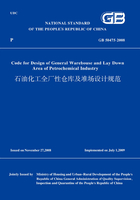
5 Storage Process
5.1 Barreled and Bagged Material Warehouse
5.1.1 The design of the barreled and bagged material warehouse shall meet the following requirements:
1 For materials with fire hazard in Class A,single-story warehouse shall be adopted.Multi-story warehouse may be adopted for other materials.
2 The finished product warehouse should be located in close proximity to the packaging building,and may be combined with packaging,handling,storage and loading functions into a complex for mechanized storage and transportation.
3 Empty barrel laydown area,empty bag laydown area or open warehouse with certain storage capacity should be established.
4 When materials which may cause chemical reaction or explosion if in contact,or corrosive material and flammable material are stored in the same warehouse,solid wall shall be set up for isolation of such materials,and separate entrances/exits shall be provided.
5 Barreled and bagged materials with fire hazard in Class A and B shall be stored in the warehouse in accordance with the current national standard GB 15603 Rule for Storage of Chemical dangers.
5.1.2 The area of the warehouse shall include the area occupied by stored materials,area occupied by handling equipment,and area occupied by aisle and passage,etc.
5.1.3 The area of the warehouse may be calculated by the loading method and determined in accordance with Appendix B to this Code.
5.1.4 For the finished product warehouse adopting stacking pallets,extra room for storage of empty pallet should be reserved with no need to establish a separate empty pallet warehouse.
5.1.5 The warehouse area utilization coefficient should be no lower than 0.50.Such utilization coefficient,under different storage methods,shall be determined in accordance with Table 5.1.5 below.
Table 5.1.5 Warehouse Area Utilization Coefficient

Note:The warehouse area utilization coefficient refers to the ratio of the effective area occupied by the stored materials to the total effective area.
5.1.6 The width of the aisle and passage in the warehouse shall be such that can ensure smooth in and out of the goods and meet the following requirements:
1 The width of the main forklift aisle should be no less than 5.00m.The minimum width of the forklift aisle may be determined in accordance with Appendix C to this Code.
2 The width of the auxiliary aisle for handling with forklift should be no less than 2.00m,or no less than 1.50m when manual handling is adopted.
5.1.7 The height of the warehouse shall meet the following requirements:
1 When no crane is provided,the headroom of the single-story warehouse should be no less than 4.00m.
2 When overhead bridge crane is provided,the headroom of the single-story warehouse should be no less than 6.50m,which shall be calculated and verified according to the model of the crane,the stacked height of the stored materials or the height of the storage rack.
3 When stacker and pallet unit are adopted and supported with forklift,the headroom should be no less than 4.5m.
4 When bridge type combined stacker is adopted,the headroom should be no less than 8.00m.
5 For multi-story warehouses,the headroom shall be no less than 4.50m in the first floor and 3.50m in the second floor and above.
5.1.8 The warehouse platform shall meet the following requirements:
1 The warehouse loading/unloading platform should be arranged in close proximity and parallel to the longitudinal axis of the warehouse.The height of the platform shall be determined according to the transport vehicle used.The railroad transport platform shall be 1.00m to 1.10m above the rail top.The truck transport platform shall be 0.80m to 1.55m above the ground level.
2 The width of the platform shall be determined according to the needs of the material handling and stacking operations.When manual handling is adopted,the platform shall be at least 2.50m wide.When forklift is used,the platform shall be at least 5.00m wide.When mobile conveyor or mobile overhead loader is used,the platform shall be at least 4.50m wide.
3 A rain shed should be provided for the loading/unloading platform,extending 3.00m beyond the edge of the platform in case of a truck loading/unloading platform or extending beyond the outside of the train compartment in case of a railroad loading/unloading platform.
5.1.9 The storage and handling method should meet the following requirements:
1 For small-sized warehouses,manual handling or stacking may be adopted.Forklift handling,stacking,storing and loading may also be adopted for manual loading warehouses.
2 For middle and large-sized warehouses,mechanized handling,storing and loading means should be adopted.
3 Overhead travelling stacker may be adopted if the weight to be handled per time is relatively light.When the stacked height is less than 4.00m,ground control can be used.In such case,the travelling speed of the overhead travelling stacker should be less than 40m/min.
4 For warehouses with stacked height above 4.00m and large storage and in-put/out-put volume,overhead travelling bag stacker adopting cab control should be used.The rail top height should be no larger than 12.00m.The span of the stacker should be no less than 18.00m.
5 When semi-automatic or automatic stacker is used,forklift should be adopted for handling and stacking.The stacked height is preferably to be the total height of 1 to 3 pallets.Also,forklift of appropriate tonnage and lifting height shall be provided.
6 For open laydown areas for barreled materials,laydown areas for unitized bagged materials or laydown areas for bagged materials wrapped with plastic film,forklift or special crane should be used for stacking,loading and transport.
7 For warehouses storing flammable or explosive materials,overhead travelling bag stacker should not be used.Otherwise,such bag stacker should be explosion-proofing and adopt ground control.
8 In case of handling unitized non-palletized materials or big bags of materials,forklift with boom or overhead travelling crane with hook shall be provided.
9 For vertical transportation within the warehouses in two stories and above,elevator or lift shall be used.Lifting equipment like manual or electric hoist or overhead travelling crane,etc.should not be used for operations spanning multiple floors.
10 When forklift is used for handling in the warehouse,common pallets shall be provided.